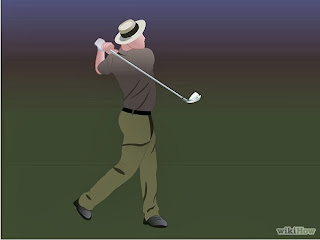Golf is a sport, but how to warm up properly is a mystery to some! Golf gymnast Rickard Strongert gives you the run down on the basics to help you swing without regrets. Warm up those important muscles and joints so your body can move freely.
Step 1: Warm up with pitch shots
If you look at professionals on the driving range before a round, you will see that almost all of them start their warm-up by hitting pitch shots with a sand wedge or pitching wedge. This lets your muscles warm up slowly, and helps you get your swing into a nice flowing rhythm.
Always warm up with a club on the ground parallel to the target to ensure that you set up square every time. As you will appreciate if you have seen our video "Why the set-up makes your swing", it is better to hit 25 balls from a perfect set-up than 200 from a faulty position. The pitch is among the shots least practiced by amateurs, but one of the most commonly played in a round of golf. Hitting pitch shots is not only a good part of your warm-up, it also ensures that you don't neglect to practice this crucial shot.
Step 2: Practice body rotations
A good way to start warming up is to practice the body rotation. Hold a club across your shoulders and stand upright. Start rotating the club, along with your shoulders and hips, backwards and forwards around your spinal axis and in a horizontal plane, making sure your body follows through until you face forwards. Then lean forwards from your hips, take your set-up position and continue to turn around your spinal axis to practice the correct body rotation for your swing. If you feel your hands are not releasing the club enough to allow the head to pass freely through the ball, take your grip and then hold the club horizontally in front of your body. Start to swing the club around you, backwards and forwards, with a relaxed rotation of your hands and body. If you are turning correctly, the club head will stay at a constant height above the ground throughout the swing.
Step 3: Practice half swings with pitching or sand wedge
Once you have practiced your body rotation, take a pitch or sand wedge and hit between 5 and 10 half swings.Then play five balls with alternate numbered irons, say 9, 7, and 5, before moving on to hybrids and fairway woods.Now take out the driver.Concentrate on swinging the ball away rather than hitting it, as shown in our video "swing not hit", and make sure you keep your balance as you swing.
Step 4: Finish with more pitches
Finally, you can return to the pitching wedge or sand wedge to finish off with a few more pitch shots and reinforce that relaxed, flowing motion.







